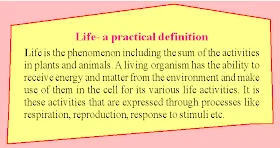സംഗ്രഹം
പ്രകാശസംശ്ലേഷണത്തിന്െറ രാസസമവാക്യം:
ഉല്പന്നങ്ങള്: ഗ്ലൂക്കോസ്, ഓക്സിജന്, ജലം.
പ്രകാശസംശ്ലഷണത്തിന്െറ രസതന്ത്രം

Pigments in the leaf and absorption of light

- സസ്യങ്ങള്ക്ക് ജീവനുണ്ട്.
- സസ്യങ്ങള്ക്കും ആഹാരം ആവശ്യമുണ്ട്.
- ഭൂമിയില് ഊര്ജത്തിന്െറ ആത്യന്തിക ഉറവിടം സൂര്യനാണ്.
- സൗരോര്ജത്തെ ആഗിരണം ചെയ്ത് രാസോര്ജമാക്കി മാറ്റാന് ഹരിതസസ്യങ്ങള്ക്കുമാത്രമേ കഴിയൂ.
- ഈ രാസപ്രവര്ത്തനത്തിനു പ്രകാശസംശ്ലേഷണം എന്നുപറയുന്നു.
- സസ്യങ്ങള്ക്കാവശ്യമായ ആഹാരം അവ പ്രകാശസംശ്ലേഷണപ്രക്രിയയിലൂടെ നിര്മ്മിക്കുന്നു.
- ചിലതരം ബാക്റ്റീരിയങ്ങള് ഒഴികെ, ഹരിതസസ്യങ്ങള്ക്കുമാത്രമേ സ്വയം ആഹാരം തയ്യാറാക്കാന് കഴിയൂ.
- മറ്റു ജീവജാലങ്ങളെല്ലാം ആഹാരത്തിനായി നേരിട്ടോ അല്ലാതെയോ ഹരിതസസ്യങ്ങളെ ആശ്രയിക്കുന്നു.
- ഹരിതസസ്യങ്ങളുടെ പച്ചനിറത്തിനു കാരണം അവയിലെ കോശങ്ങളിലടങ്ങിയിരിക്കുന്ന ഹരിതകമാണ്.
- ഇലകളിലല്ലാതെ ഹരിതകമുള്ള മറ്റുസസ്യഭാഗങ്ങളിലും പ്രകാശസംശ്ലേഷണം നടക്കും.
- കാര്ബണ്, ഹൈഡ്രജന്, ഓക്സിജന് എന്നീ മൂലകങ്ങള് അടങ്ങിയിട്ടുള്ള സംയുക്തങ്ങളില് ഒരു വിഭാഗമാണു ധാന്യകങ്ങള്. ധാന്യകങ്ങളില് ജലത്തില് ലയിക്കാത്ത രൂപമാണ് അന്നജം. നെന്മണിയിലും മരച്ചീനിക്കിഴങ്ങിലും ഉള്ളത് അന്നജമാണ്.
- ധാന്യകങ്ങളില് ജലത്തില് ലയിക്കുന്ന രൂപങ്ങളാണ് പഞ്ചസാരകള് - അതായത് ഗ്ലൂക്കോസ്, ഫ്രക്റ്റോസ്, സുക്രോസ് മുതലായവ.
- ഏറ്റവും ലളിതഘടനയുള്ള പഞ്ചസാരയാണ് ഗ്ലൂക്കോസ്.
പ്രകാശസംശ്ലേഷണം
- ഇത് ഹരിതസസ്യങ്ങള്ക്കുമാത്രം ചെയ്യാന്കഴിയുന്ന പ്രവര്ത്തനമാണ്.
- ഈ പ്രവര്ത്തനം നടക്കാന് കാര്ബണ് ഡയോക്സൈഡ്, ജലം, സൂര്യപ്രകാശം, ഹരിതകം എന്നീ നാലു ഘടകങ്ങള് ആവശ്യമാണ്.
- ഘടകപദാര്ത്ഥങ്ങളെ കൂട്ടിച്ചേര്ത്ത് പുതിയ പദാര്ത്ഥം നിര്മ്മിക്കുന്ന പ്രവര്ത്തനമായതുകൊണ്ടാണ് ഇതിനെ സംശ്ലേഷണ പ്രവര്ത്തനം എന്നു പറയുന്നത്.
- ഈ സംശ്ലേഷണ പ്രവര്ത്തനത്തിന് പ്രകാശം അത്യാവശ്യമായതുകൊണ്ടാണ് ഇതിനെ പ്രകാശസംശ്ലേഷണം എന്നു പറയുന്നത്.
പ്രകാശസംശ്ലേഷണത്തിന്െറ രാസസമവാക്യം:
ഉല്പന്നങ്ങള്: ഗ്ലൂക്കോസ്, ഓക്സിജന്, ജലം.
പ്രകാശസംശ്ലഷണത്തിന്െറ രസതന്ത്രം
- മൂലലോമങ്ങള് മണ്ണില്നിന്നും വലിച്ചെടുക്കുന്ന ജലം സൈലം കുഴലുകളിലൂടെ ഇലയിലെത്തുന്നു.
- അന്തരീക്ഷത്തിലെ കാര്ബണ് ഡയോക്സൈഡ് ആസ്യരന്ധ്രങ്ങള് വഴി ഇലയ്ക്കുള്ളില് കടന്ന് ഇലകളിലെ കോശങ്ങളില് വ്യാപിക്കുന്നു.
- ഇലയിലെ പാലിസേഡ് കോശങ്ങളില് ഹരിതകണങ്ങള് ധാരാളമായിട്ടുണ്ട്.
- ഹരിതകണത്തില് ഗ്രാന, സ്ട്രോമ എന്നീ ഭാഗങ്ങളും ജലവും കാണപ്പെടുന്നു.
- പ്രകാശസംശ്ലേഷണത്തിന് രണ്ടു ഘട്ടങ്ങളുണ്ട്. അവ (1) പ്രകാശഘട്ടം (2) ഇരുണ്ടഘട്ടം എന്നിവയാണ്.
- ഗ്രാനയില്വച്ചാണ് പ്രകാശഘട്ടം നടക്കുന്നത്. ഈ ഘട്ടത്തില് ജലം വിഘടിച്ച് ഹൈഡ്രജനും ഓക്സിജനുമായി മാറുന്നു. ഈ പ്രവര്ത്തനം പ്രകാശത്തിന്െറ സാന്നിദ്ധ്യത്തില് മാത്രമേ നടക്കൂ. അതുകൊണ്ടാണ് ഇതിനെ പ്രകാശഘട്ടം എന്നു പറയുന്നത്.
- ഇരുണ്ട ഘട്ടം സ്ട്രോമയില്വച്ചു നടക്കുന്നു. ഈ ഘട്ടത്തില് കാര്ബണ് ഡയോക്സൈഡ് ഹൈഡ്രജനുമായിചേര്ന്ന് നിരോക്സീകരിക്കപ്പെട്ട് ഗ്ലൂക്കോസ് തന്മാത്ര ഉണ്ടാകുന്നു.
- ഈ ഘട്ടത്തില് പ്രകാശം ആവശ്യമില്ല. (ഇരുണ്ട ഘട്ടം എന്നതിന് ഇരുട്ട് വേണ്ട ഘട്ടം എന്നര്ത്ഥമില്ല. പ്രകാശം ആവശ്യമില്ലാത്ത ഘട്ടം എന്നേ അര്ത്ഥമുള്ളൂ.)
- പ്രകാശസംശ്ലേഷണത്തിലൂടെ ഹരിതസസ്യങ്ങള് പ്രകാശോര്ജത്തെ രാസോര്ജമാക്കി മാറ്റി ആഹാരകണികകളില് സംഭരിക്കുന്നു. നിര്മ്മിക്കപ്പെടുന്ന ഗ്ലൂക്കോസ് അന്നജമായി മാറുകയും ചെയ്യുന്നു.

The Sign of Life
To remember
Life : Life is the phenomenon in which energy and matter are absorbed from the environment and there is the expression of activities such as growth, respiration, reproduction, response to stimuli and so on.
- Metabolism : The activities of anabolism and catabolism.
- Anabolism : The process in which complex substances are formed by the assimilation of simple substances. eg: Photosynthesis
- Catabolism : The process in which complex substances inside the cell break down to form energy. eg: Respiration.
- Photosynthesis : The process in which green plants produce food (glucose) by combining CO2 and water using the energy from the sun.
- Two main forms of chlorophyll : Chlorophyll a , Chlorophyll b.
- Pigments : Chlorophyll, Carotene, Xanthophyll.
- Component colours in white light that play the major role in photosynthesis : Red rays and Blue rays.
Origin of life
- There were many inorganic substances in the atmosphere of the primordial earth (Primordial-earliest formed). They combined together to form certain inorganic compounds. Along with the rains that went on for thousands of years, these compounds reached the ocean. In course of time the primitive form of life came into being in the ocean.
- This early form of life developed into autotrophs and heterotrophs as the result of evolution through millions of years. [autotrophs: organisms that can prepare food on their own ; heterotrophs : organisms that depend directly or indirectly on autotrophs for their food.]
- Living organisms show certain signs of life such as growth, movement, reproduction etc.
- Living organisms exhibit metabloic activities. All the life activities taking place in the body of a living organism are together known as metabolic activities.
Location and structure of the chloroplast
- Chloroplast is an organelle found in plant cells. (An organelle is any part of a cell that has a particular structure and function.)
- It has a radius of 1-4 micrometres.
- One green cell has 40 to 50 chloroplasts.
- There are approximately 50000 chloroplasts in a square millimetre of leaf surface.
- There is a watery fluid called stroma inside the chloroplast.
- There are flattened sacs called lamellae in the stroma (sing.lamella)
- The lamellae lying close together in some parts are called grana (sing. granum)
- Chlorophyll is seen in the lamellae. There are also enzymes and starch granules in the lamellae.
- In the leaf there are pigments called carotinoids and xanthophylls in addition to chlorophyll.
- Chlorophyll exists in different forms. Among them chlorophyll a and chlorophyll b are the most common ones. Of these chlorophyll a is directly involved in photosynthesis.
- Of all the pigments, chlorophyll a comprises 75%.
- It absorbs the red and blue rays of the spectrum.
- Chlorophyll b absorbs light of different wavelengths and transfers them to chlorophyll a.
- Chlorophyll a absorbs energy and synthesises carbohydrate. The other types of chlorophyll transfer the energy absorbed to chlorophyll a.
- There are autotrophs other than green plants. There are some bacteria also that are autotrophic. Cyanabacteria are examples. They prepare food without the help of light.
- They produce energy by exidising inorganic substances from the surroundings.
- This kind of preparation of food without the involvement of light is called chemosynthesis.











